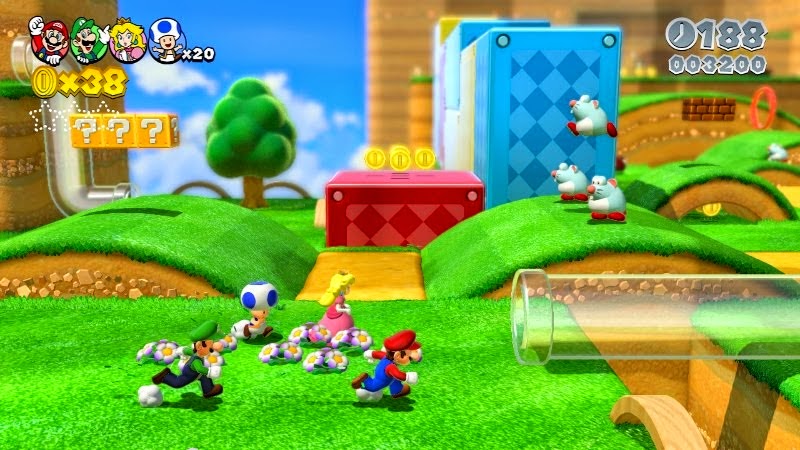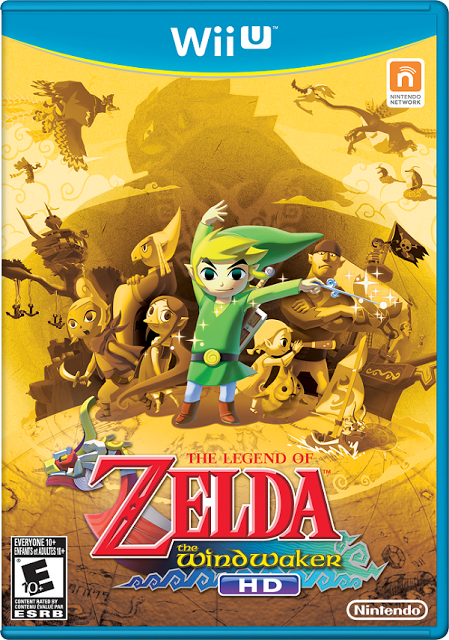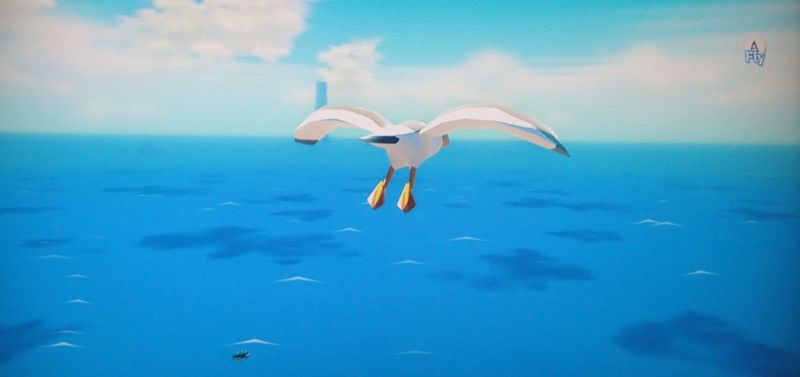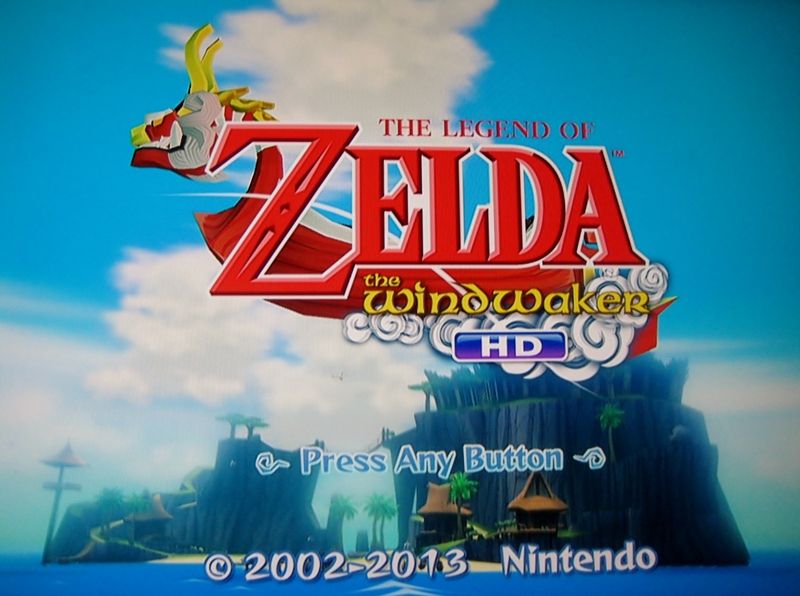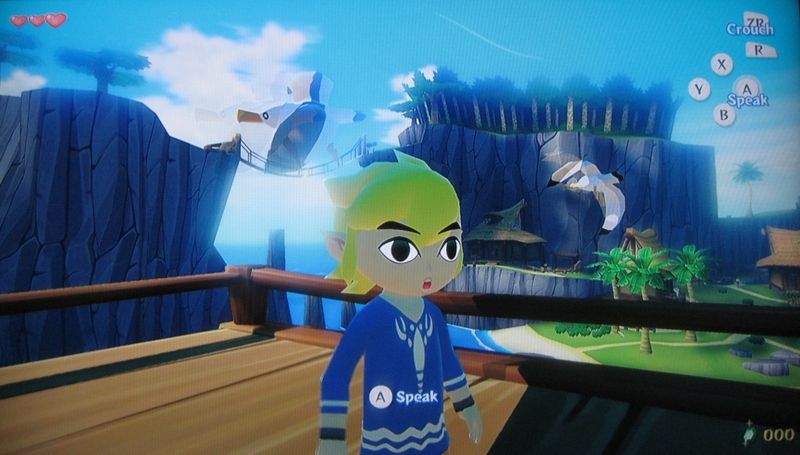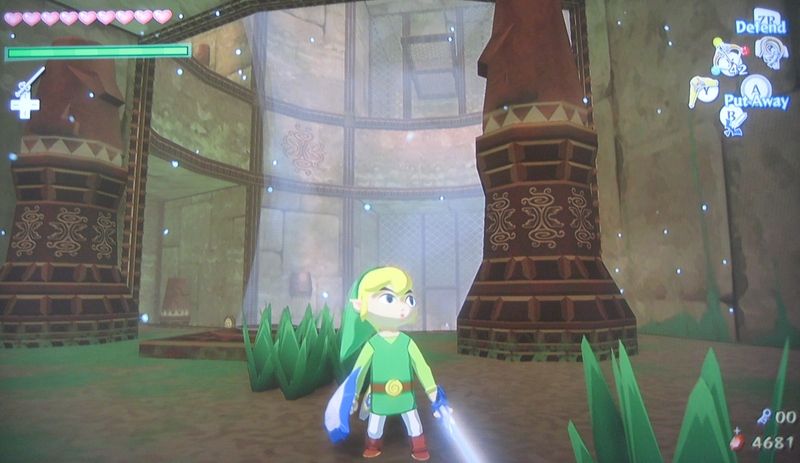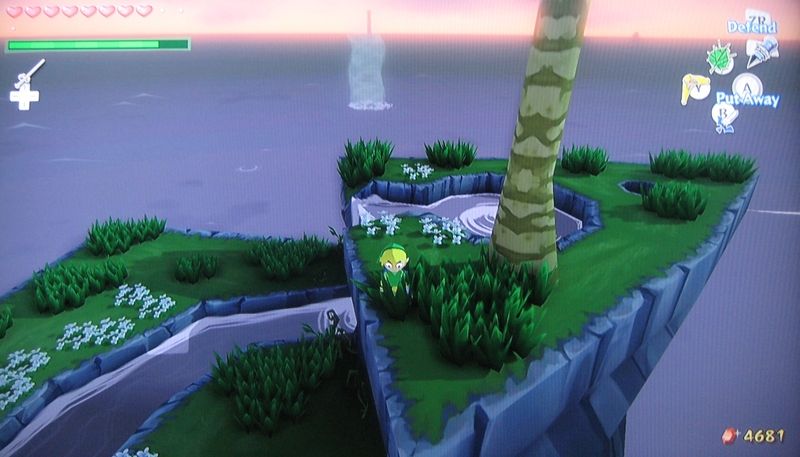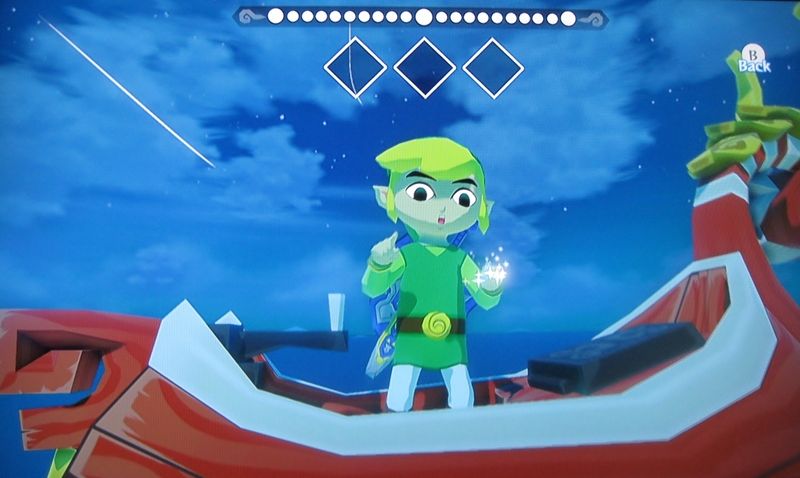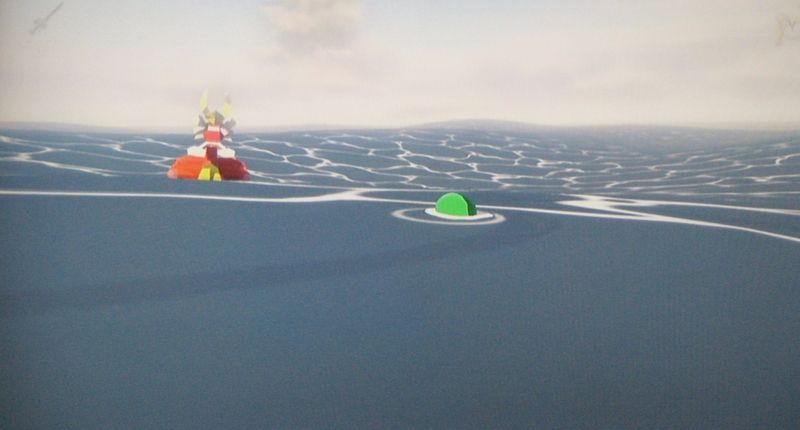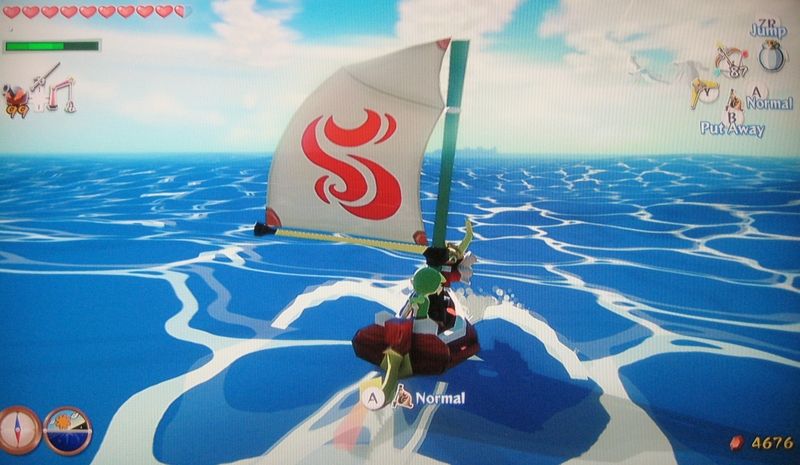
The Legend of Zelda: Twilight Princess HD
Released on the Wii U, March 4, 2016, by Nintendo and Tantalus
Retail: $59.99
Wii U Game Reviews Score: 9.7/10

And now I come full circle with these reviews. When I went on a stupid, self-imposed video game-hiatus ten years ago, I managed to perfectly time its start with the release of the newest game in my favorite video game series. I kept tabs on Twilight Princess' review scores, growing more depressed with every perfect or near-perfect score.
"Are you sure you don't want to get a Wii?" my new wife asked me repeatedly.
"No. If I do, I'll play forever, and you'll divorce me," I answered moronically.
Well, with the release of Twilight Princess HD, a few years after the end of my video game hiatus, I can safely say that playing through the game will not result in a divorce. But is the game, ten years after its original creation, any good?

Oh cool, a game where some weird dwarf lady rides a giant wolf. Where are the pictures from the Zelda game?
That is from the Zelda game. As much as Twilight Princess is accused as being a throwback to 1998's The Legend of Zelda: Ocarina of Time, a very large element of Twilight Princess' gameplay is unique to Twilight Princess. Also, spoiler alert: I really love this game because it is a throwback to Ocarina of Time.

Hi, Epona. I've missed you.
Let's get the classic Zelda elements out of the way, and by classic, I mean Ocarina of Time elements. After all, Ocarina of Time, possibly the greatest video game of all time, is simply a 3D update of The Legend of Zelda: A Link to the Past, also possibly the greatest game of all time, which is a higher pixel update of The Legend of Zelda (really awesome, but not quite one of the greatest games of all time). Like those great games of the past, Twilight Princess takes place in an ancient, medieval-like fantasy land called Hyrule, and stars a wet-behind-the-ears kid named Link. The player, as Link, gradually accumulates greater skills and weapons, traveres Hyrule's varied terrain, and dives into dungeons to fight enemies, solve puzzles collect items, defeat bosses, and collect some talisman that progresses the plot of the game. Twilight Princess, unlike its immediate Zelda game predecessor, The Wind Waker, does not break the mold. The Wind Waker was a huge departure from previous games in the Zelda series, instead sending out a now cartoony, cel-shaded young Link on a nautical adventure. After Wind Waker, a return to the familiar was certainly necessary...at least for me.

There's no place like home, there's no place like home.
Thankfully, this means building on the foundation of previous Zelda games: putting Link in a larger, more lifelike, graphically enhanced Hyrule, further evolving his abilities, and fine-tuning the games' controls,
As you can see from the above screenshot, Twilight Princess certainly presents a more lifelike, graphically enhanced vision of Hyrule than Ocarina of Time. While Twilight Princess' visuals might not compare with those of its contemporaries on the XBox 360 and PS3, and even though the it was actually designed for the older Gamecube and not the under-powered Wii, Twilight Princess is a good-looking game. Environments are lively and vibrant, evocative and full of motion. Link, non-player characters, enemies, and the game's giant bosses are animated better than ever. The HD upgrade for the Wii U gives these ten-year old graphics a boost--the game holds up again. I really have only one complaint, and it's visible in the below screenshot.

It goes. Through walls.
Your sword goes through walls. Yep, through walls. For some reason, the collision detection between Link's sword and many non-enemy textures does not exist. Not only do the polygons for the sword go through the walls, but the classic clink sound your sword made when it hit against walls in previous Zelda games is generally absent--because the game doesn't realize you are hitting anything. And before we get to the rest of the game, I'll reiterate again--THIS IS MY ONE COMPLAINT WITH TWILIGHT PRINCESS HD. For it, I deducted .3 points from the final score. This is an inexcusable detraction from an otherwise completely immersive game.
Back to the good, i.e., everything else.
Ocarina of Time introduced a lock-on combat system ("Z-Targeting"), where the player can hit a button to zero in and circle around a chosen foe. This was one of the hugest innovations in 3D gaming, greatly simplifying an experience that in previous 3D games had not felt very natural. Wind Waker further refined that element, adding additional moves for Link to master, though I feel that that game encouraged button mashing a bit. Twilight Princess brings Zelda combat experience to the next level, encouraging and empowering the player to become even more a master swordsman that did previous games. Fights in Twilight Princess feel more epic than ever, particularly when Link has to face off with huge, armored foes later in the game.
Twilight Princess also (THANKFULLY) brings back Epona the horse as Link's main mode of long-distance transportation. Peter Jackson's original Lord of the Rings trilogy is a huge influence on Twilight Princess, as the game-makers appear to have taken those films' horseback fighting scenes as a challenge. Link races Epona along goblins riding giant boars, able to cut the monsters down with his sword or bow. These segments of the game are incredible, an adrenaline rush of speed and clanging steel. There are key story moments from the game featuring horse-mounted combat, but later on, the player can hop onto Epona, venture to certain portions of Hyrule Field, and fight boar-riders any time they please.

Yes, those are fire arrows raining down upon me. Yes, this game is awesome.
I can't speak to how these horse-riding portions of the game controlled on the Wii or Gamecube, but on the Wii U gamepad, I forgot I was even holding a controller. The controls are seamless and intuitive.

So, uh...you like fishing?
How's it sound when you're doing all that stuff?
It sounds awesome. Outside of the aforementioned lack of sword-to-wall click, the sound effects sound authentic. Link still doesn't talk (He should never talk! He's a silent hero!), and characters communicate via text-box, but Link's grunts and yells are great. Sound effects during fights are as intense as they should be. Monsters make blood-curdling calls. Arrows whooshing all around. It's nice. But the true standout in this department is Twilight Princess' musical score.
A Link to the Past and Ocarina of Time both have all-time great soundtracks, and fortunately, of all the Zelda games not scored by the legendary Koji Kondo (i.e., A Link to the Past and Ocarina of Time), Twilight Princess' is the best. Nintendo assigned relatively green composer, Toru Minegishi, with the task of creating the game's music (with assistance from Asuka Ohta). Minegishi is apparently a huge student of Kondo's compositions because Twilight Princess' music sounds like a natural evolution of the maestro's work. Yes, I just called Koji Kondo "the maestro." He's created some of the most memorable compositions of all time, and deserves the title. Any doubt cast on my previous statement can be immediately extinguished by attending a Symphony of the Goddesses concert. And if you already don't have any doubt, you definitely need to attend a Symphony of the Goddesses concert. I did, cried the whole time, and had a transcendent experience--it was truly a magical night. Kondo gives a pre-recorded speech where he explains how he attempts to stir empathy in the listener when he composes a Zelda soundtrack. Incredible.

If you come here as a wolf, everyone pays a bit more attention to you.
The music in Twilight Princess is awesome: thrilling in Hyrule Field, incredibly relaxing anytime Link is near water, mysterious when he is traversing a misty forest, furious during a fight. The dungeon music, while not quite on the level of Kondo's haunting compositions, are a step above Wind Waker's. particularly Minegishi's work on Arbiter's Grounds. Minegishi also reprises and reinterprets Kondo's themes at key moments
So I've talked about everything Twilight Princess has in common with previous Zelda games. Now it's time to get to what's new.
You mean the wolf?
I mean the wolf.

Hungry like the.
Twilight Princess' biggest departure from the Zelda series is that, during certain segments of gameplay, Link is turned into a wolf. As the wolf, Link's attack moves (option 1. bite. option 2. bite) become limited, though his mobility and senses are enhanced. At first, playing as the wolf is a function of the story and mandatory, but later in the game, the player is free to switch between the two forms. These segments are a nice change of pace, and never take long enough to wear out their welcome. They also add to Twilight Princess' already thick atmosphere.
What's so thick about it?
The atmosphere arises from Twilight Princess' storyline. Zelda games are generally a simple battle of good versus evil, with a few extra details tossed in, but Twilight Princess does a great job of presenting something a bit more complex, without losing that classic Zelda feeling. The story this time has to do with a Twilight Realm that is essentially a parallel dimension, existing directly on top of Hyrule. In a twist, our main three characters, courageous Link, wise Princess Zelda, and powerful (evil) sorcerer Gannondorf are roped into the dramatics of this other world, and the game's action bounces between the Twilight Realm and Hyrule. I won't give anymore away, but the storyline is engaging and involving, and brings to the fore Link's greatest companion to date: Midna.

My apologies to Navi.
Midna possesses a certain attitude unique to the Zelda series, as she is possibly more powerful than Link himself. From early in the game, she is always near, riding Wolf Link in the Twilight Realm, and right behind Human Link in Hyrule. Her advice is always helpful, her jibes enjoyable, and her warping abilities later in the game eliminate any tedious backtracking.
To tie together everything that's new and old, I think Twilight Princess can be best summed up by its dungeons. While the Zelda overworld is a place to ride free and explore, meet new characters, and fight minor enemies, Link's journeys underground (and in one case, far over ground) to the dungeons truly test his, and by extension the player's mettle. That was a lot of commas, sorry.
Twilight Princess' dungeons, in a hyphenated word, are awe-inspiring. Their sense of scale, ingenuity in puzzles and gameplay, and diversity in aesthetic design are some of the greatest the Zelda series has to offer. Best of all, the incorporation of Wolf Link into the dungeons (after his use becomes optional) makes Twilight Princess an even more memorable experience. The amount of thought the game designers put into these dungeons, accounting for both Human and Wolf Link, is astounding. If you play this game for one reason, make it the dungeons. I repeat, Twilight Princess has some good dungeons. The dungeons are great. In case I haven't made myself clear...dungeons!

Pictured above...not a dungeon.
And finally, an HD upgrade isn't Twilight Princess' only Wii U improvement. Like Wind Waker HD before it, Twilight Princess HD sports a menu screen on the Wii U's Gamepad touch-screen controller. This means that the player can select and change out items or look at the game map without pausing. This Wii U innovation will be missed in the future, when Nintendo inevitably makes a course correction with following systems, and ditches the Gamepad screen. I can say with conviction, having that little additional screen for any 3D game involving exploration and an inventory has been a real bonus. I wish Nintendo could have found some way to make the Wii U catch on. It is going to be difficult playing future Zelda games without it.

Pictured above: startlingly, something actually apt to what I just talked about--the Gamepad touch-screen...and my items. Yes, that was a colon, hyphen, and suspension point in just one caption. Deal with it!
Double finally, I've heard some people complain about the emptiness of Twilight Princess' Hyrule Field overworld. Hyrule Field surrounds game-central Hyrule Castle, and leads to Hyrule's lake, forests, fire, and icy lands. The game makes quite clear that this Hyrule is a once great land that has fallen into disrepair. There are ruins everywhere, fallen columns, broken stone bridges. Yes, while Hyrule fields sports loads of enemies and secrets, there are certain sections that are a bit lonely--and this only serves to drive home this feeling of desolation all the more.
As a design choice, I think this is brilliant. It's not like the player has to ride for minutes through empty terrain--there is just a tangible feeling of emptiness, and that this is a world that was once thriving and connected, but now broken and dying.

Hey, look, a broken and dying little Goron...just kidding...I'm sure he's probably fine.
This is reiterated by the strife and paranoia between Hyrule's various intelligent species, which is gradually alleviated by Link as he opens the land and connects once separated areas togethger. It's clear there was once closer relationships between the humans, Gorons, Zoras, etc., but years of Hyrulian decay have severed these ties.
The best Zelda games champion exploration. My favorite moment came when I discovered an ancient, ruined theater on a hillside. Boar-riding orcs aren't the only Lord of the Rings influence on Twilight Princess. Making this discovery reminded me of Aragorn's wistful words about Weathertop. One could easily imagine the peoples of Hyrule seated at this theater long ago, gathered together in a period of unity and artistic prosperity. Now the area is overrun by monsters, as the humans huddle together behind the castle walls.
Pfft. Empty.

It's also a perfect place for target practice.

I'll show these birds to gather.
This sense of a land with a deep past links beautifully into past games, as well. For instance, villainous Gannondorf's race, the Gerudos, are mysteriously absent from the game. However, the desert still shares their name, and in the center of it is a great, ruined prison dungeon full of bones--a fitting resting place for a people whose leader attempted to mold Hyrule to his will.
At night, Hyrule Field's boisterous, dynamic musical theme segues to a quiet, meditative piece, punctuated by mysterious singing. The voice is that of Malon from Ocarina of Time, which occurred centuries before Twilight Princess. Malon was a ranch hand who befriended Link in Ocarina, and a possible shared romantic future is hinted between the two. Twilight Princess' Link lives on a ranch. Is this the voice of his ancestor comforting him in the night? Twilight Princess is full of this hinted past.
Not all of it is hinted, though. The ancient Ocarina Link is actually in this game. His spirit comes at select moments to train Twilight Princess' Link in combat.

The Hero of Time stands apart from it.
One wouldn't catch on to this without having first played Ocarina of Time, which is not a detriment to Twilight Princess at all. However, as this gnarly old skeleton recalls moments from his past adventures, and teaches Link the songs of his youth, Ocarina fans will be smiling with the recollection of each note.
Oh yeah, and you can go fishing. If you get the time, you should probably go fishing.

Gonna catch me a biggun.
